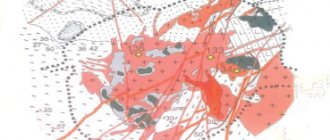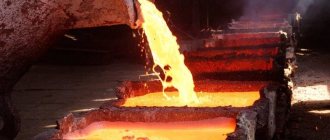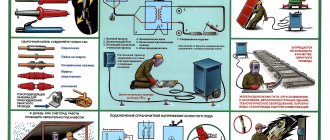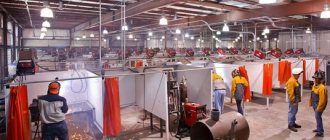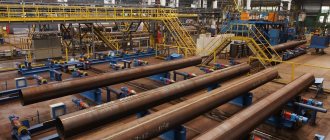Natural materials that contain nickel in quantities that allow it to be extracted with maximum economic benefit are called nickel ores. Among them, there are two main types: copper-nickel sulfide and nickel silicate.
Nickel ore is formed, like other ores, as a result of the cooling and crystallization of magma containing metal compounds.
Nickel ore deposits
The morphology of ore bodies, geological conditions of occurrence, the mineral and material composition of ores, as well as the features of their technological processing - all this together allows one or another deposit to be classified as a certain class.
Basically, nickel deposits are divided into:
- Copper-nickel sulfide. This type of nickel deposits is found in Canada (Thompson and the Sudbury ore district), Australia (Kambalda), and in the CIS countries (Norilskoye, Talnakhskoye, Oktyabrskoye, Monchegorskoye, Kaula, etc.);
- Nickel silicate and cobalt-nickel silicate, as well as oxide-silicate ferro-nickel. Such deposits can be found mainly in the Southern Urals, Bug region, as well as in Cuba, Indonesia, New Caledonia, Australia;
- Copper-pyrites;
- Vein sulfide-arsenide complex.
The last two types of deposits are classified as secondary.
Table 1. Main nickel deposits in Russia
| Field | Ore type | Share in Russian reserves, % | Nickel content in ores, % | Production in 2006, thousand tons; |
| Oktyabrskoye (Taimyr Autonomous Okrug) | Sulfide copper-nickel | 40,3% | 0,87% | 220,2 |
| Talnakh (Taimyr Autonomous Okrug) | 25,8% | 0,7% | 39,1 | — |
| Zhdanovskoe (Murmansk region) | 13,4% | 0,56% | 32,8 | — |
| Buruktalskoe (Orenburg region) | Nickel silicate | 7,2% | 0,64% | 10,6 |
It is worth noting that ferromanganese nodules located on the ocean floor can also be considered as a potential source of nickel ores.
Ore formation in copper-nickel sulfide deposits occurs in several stages. Initially, there is a homogeneous nickel-bearing melt, which, under certain conditions, is divided into silicate and sulfide components. The sulfide melt is distinguished by its large weight, under the influence of which it settles and concentrates in the bottom parts of the intrusions. Its crystallization occurs only after the complete completion of the silicate melt. Nickel-bearing magma rises along deep faults, determining the geological position of ore areas and fields of this type of deposit.
The ore bodies of the largest deposits are distinguished by their sheet-like shape, which, as a rule, coincides with the direction of layering of intrusive massifs. There is also a vein form of ore bodies, columnar or other, more complex, which is determined by discontinuities.
The distinctive characteristics of this type of deposit are the presence of a consistent mineral composition of the ores.
For deposits belonging to the second type, the formation is characterized by weathering of serpentenites, during which minerals decompose, and also the movement of some mobile elements by water flows to lower areas of the earth's crust, where the elements form sediment in the form of secondary minerals.
These deposits are famous for their large number of nickel deposits, which are three times larger than the reserves of nickel in sulfide ores. The largest deposits include those located in the Philippines, New Caledonia, Indonesia, and Australia.
Deposits belonging to the second type are divided into:
- areal cortex;
- linear-areal cortex;
- linear;
- having a complex morphology of ore bodies.
Nickel properties
In the course of further research, it was possible to establish other properties of nickel, thanks to which it became widespread in industry. This was facilitated by its wide distribution in deposits around the world - mineralologists and chemists from different countries contributed to the study. Due to this, soon after the element was officially described, its characteristics were well known.
Metal
As a mineral mined together with ore, nickel was of interest primarily as a metal. It has standard parameters:
- characteristic shade and shine;
- occurrence in mineral-containing rocks - sulfides and silicates;
- susceptibility to oxidation;
- hardness and strength.
Nickel is considered a heavy non-ferrous metal, along with copper, lead and tin.
Physical
One of the main characteristics that was established in the first years of discovery and research is the high ductility and malleability of nickel. Other characteristics were also established:
- attracted by a magnet (ferromagnetic);
- high heat resistance;
- high corrosion resistance;
- thermal conductivity, which decreases when heated;
- melting point - 1455 °C;
- specific electrical resistance 0.0684 µOhm.
Its properties make it possible to use nickel in the production of stainless steel and reagents. Also, due to its heat resistance, it serves as the basis for alloys for the aerospace industry.
Nickel industry
Historical sources indicate the use of nickel in ancient times. However, its official discovery occurred only in the mid-18th century - in 1751. For a whole century, until the end of the 19th century, nickel mining was not scaled up and was carried out exclusively in the territory of certain countries, which included Germany, Greece, Italy, Norway, and Sweden. Only by the 80s of the 19th century was a more active phase of development of the nickel industry observed, which was associated with the development of large deposits in New Caledonia and the Canadian Sudbury deposit.
Nickel production in Russia also began in the 19th century. The first nickel ore deposit found on the territory of the Russian Federation is the Petrovskoye deposit, located in the Middle Urals. It was discovered at the beginning of the 19th century, but was mistakenly taken for a copper ore deposit. But all attempts to extract copper from this deposit were in vain, and therefore it was abandoned until 1855. It was then that one of the engineers determined the presence of nickel in the ore. After some time, over the course of four whole years, it was possible to extract about 60 tons of nickel metal from this deposit. By the end of the century, a number of more deposits were discovered in the Middle Urals, which include Istokinskoye, Ivanovskoye, Urgunskoye, Verkhneevinskoye.
Despite the intensive start of nickel production at the local level, over time the development of these deposits was stopped. The main reasons for this were limited explored reserves, as well as competition from nickel mined in New Caledonia and Canada, which was significantly cheaper in price. At the beginning of the 20th century, the second stage of development of nickel deposits began. It was preceded by the discovery of new metal deposits. At the same time, the construction of nickel enterprises began, the first of which was the Revdinsky plant, which smelted about 40 tons of nickel during the First World War.
On the territory of the USSR, the first nickel production enterprise was opened in 1933. Beginning in 1938, Yuzhuralnickel was also put into operation, and in 1942 the first batch of nickel was received from the facilities of the Norilsk Mining and Metallurgical Combine. After the end of World War II, nickel plants continued to open. Thus, Pechenganikel and Pobuzhsky Nickel are being launched.
Currently, the nickel industry continues to develop successfully.
The importance of Norilsk ores in the economy of the region and Russia
The Norilsk Combine today is a quarry (“Norilsk I”), 5 mines, 2 processing plants, metallurgical production, energy enterprises and much more. Deposits are developed by open-pit and underground methods. The Zapolyarny mine and the Medvezhiy Ruchey quarry operate at the Norilsk deposit. The Talnakh and Oktyabrskoye fields are exploited underground. As a result of enrichment, nickel, copper and pyrrhotite concentrates are obtained, which are sent to the metallurgical plant. The unique deposits of the Talnakh ore cluster - Talnakhskoye (Mayak and Komsomolsky mines) and Oktyabrskoye (Oktyabrsky and Taimyrsky mines) - are the main ore base of the mining and metallurgical industry. Here are more than 40% of the world's proven reserves of platinum group metals, more than 35% of nickel, about 10% of copper and 15% of cobalt. MMC Norilsk Nickel is the largest industrial complex in the Krasnoyarsk Territory and the main taxpayer of the region, whose contributions bring about a third of income to the regional treasury.
The entire Norilsk industrial region, including the villages and cities of Norilsk and Dudinka, is supplied with local coal, gas (the Pelyatka gas condensate field) and electricity (gas-fired thermal power plants). The work of most residents is related to the plant or the service sector of its employees.
Source Instagrammy.krskstate.ru
Tags
winter quarry snow cold Norilsk frost
World reserves
Data taken from different sources are very contradictory and differ greatly in terms of years, mineral content, as well as in the level of confirmed reliability by expert services.
The identified resources of nickel ores are estimated at 190-210 million tons. Of these, most of them have a nickel concentration of over 1% (130 million tons), a smaller part with a concentration of 0.2-1% (80 million tons). Huge deposits of this unique mineral are located at the bottom of the world's oceans (almost 700 million tons), although they have an average concentration of this mineral.
It is difficult to say which country has the largest reserves of nickel ore. One thing can be said with a fair degree of confidence that the list of leaders (countries with more than 5 million tons of deposits of this resource) includes: Australia, Brazil, Indonesia, Canada, Cuba, Russia, New Caledonia. The following countries also have significant reserves (more than 1 million tons): Albania, Greece, the territory of the former Yugoslavia, Ukraine, Kazakhstan, Guatemala, Colombia, Burkina Faso, Burundi, Ivory Coast, Madagascar, South Africa, China, the Philippines, Papua New Guinea.
Cobalt
World cobalt reserves are estimated at approximately 500 million tons, of which proven reserves in 2005 amount to almost 13 million tons.
Classification
Depending on the needs of a particular industrial application, nickel of one grade or another is used. They differ in metal content and type of raw material.
- Primary nickel. It is characterized by high content - 99.99 and 93.93% for brands HO, H1. It is obtained during electrolysis and produced in plates or strips. It can also be obtained during remelting or refining - in this case it is supplied in ingots, trimmings or granules. Marked with numbers from 2 to 4.
- Semi-finished. It consists of sheets, rods, wire. According to the standard, the nickel content is also high, comparable to primary, but it is already marked with the letters NP. Can be produced in rod form (anodic nickel, grades NPA1 and 2).
- Modifications of anodic grades on the surface of which a film does not form. It is classified as non-passivable and has a special designation - NPAN.
Also, flint or manganese may be added during the production process. Usually comes in wire form. The added elements are included in the labeling - NKO and NMC, respectively.
In some industries, the use of nickel with better characteristics is unjustified and results in unnecessary costs for raw materials and manufacturing of products. Therefore, for the manufacture of conventional alloys and workpieces, more inexpensive varieties are used.
Processed product
Steel and alloys
Due to its unique properties: ductility, heat resistance, resistance to chemical influences and non-reaction with oxygen, the metal is highly valued by metallurgists. Most of the nickel produced is used to make stainless steel.
Quite a significant amount is used to produce alloys with copper, iron and chromium. It is they, due to their heat resistance, that are widely in demand in the production of gas turbine and jet plants in aircraft manufacturing, rocket science, astronautics, and nuclear energy.
We should not forget about such an important process as nickel plating of surfaces, which is used to protect surfaces and give them a characteristic appearance.
Cobalt is used to alloy steels, which significantly increases their hardness and strength. It is these grades of steel that are used for the manufacture of metal-cutting tools.
Devices for the chemical and food industries
Nickel steel, which is heat-resistant and does not corrode for a long time, is widely used in the chemical industry. A significant number of tanks, tanks, boilers, crucibles, pipes, machine parts and mechanisms used in the industry contain this amazing metal. Containers for chemical reagents are produced from it. In addition, the mineral itself is often used as a catalyst for chemical processes.
Also, materials containing nickel are used in the manufacture of containers for storing and processing a significant amount of food products.
Equipment for nuclear power plants
Modern nuclear power plants contain iron- and nickel-based alloys in their reactor vessels and piping. Nickel-based superalloys have also been used as materials for equipment in nuclear power plants. They are commonly known as:
- Inconel – nickel-chromium heat-resistant alloy,
- Hastelloy is an alloy with high corrosion resistance.
Radar devices
Products made of nickel and its alloys are widely used in the manufacture of instruments and electronic components:
- Nickel pipes are widely in demand in navigation devices, remote control systems, and television.
- Nickel alloys are used in the construction of antenna units, satellite communication devices and in the manufacture of telecommunication elements.
Nickel mining methods
Deposit development is carried out using several methods. The choice is related to the type of ore as well as production costs.
- Open method. It is a quarry. Using machines, ore is extracted from stepped walls, after which it is transported to the surface using excavators and dump trucks.
- Closed. Occurs at a depth of a kilometer or less. It is characterized by a greater degree of danger and large expenses for machinery and equipment.
- Mining from the seabed. The most expensive method, with limited processing capabilities at the extraction site.
Mines and wells are installed in places that contain associated minerals with beneficial properties. This allows you to recoup production costs. The optimal method of extraction remains a conventional quarry.

